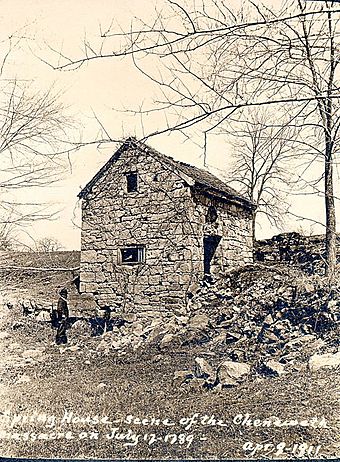Chenoweth Fort-Springhouse facts for kids
Quick facts for kids |
|
|
Chenoweth Fort-Springhouse
|
|
 |
|
| Location | Avoca Rd., Middletown, Kentucky |
|---|---|
| Area | 1 acre (0.40 ha) |
| Built | 1786 |
| Built by | Chenoweth, Richard |
| NRHP reference No. | 75000779 |
| Added to NRHP | July 1, 1975 |
The Chenoweth Fort-Springhouse is a very old stone building near Avoca Road in Middletown, Kentucky. It was built around 1786. Many people believe it is the oldest building still standing in Jefferson County.
This historic springhouse was also the site of an important event in 1789. During the Northwest Indian War, a group of Native Americans attacked the home of Captain Richard Chenoweth. His family took shelter in this strong stone building. The springhouse was added to the National Register of Historic Places in 1975. It is on land that is owned by a private company.
Contents
The Chenoweth Fort-Springhouse: A Historic Stone Building
The Chenoweth Fort-Springhouse is located in a wooded area. It is near Avoca Road in northeastern Middletown. The building sits close to where two small streams, called Chenoweth Run, meet. Over the years, new roads and a railroad track have been built. These constructions have separated the springhouse from the stream.
What Does the Springhouse Look Like?
This stone building has two floors. It was built on a small hill right over a natural spring. The springhouse was made to be very strong and could be used for defense.
You can enter the building in two ways. There is a main entrance on the ground floor. There is also another entrance on the upper floor. To reach the upper entrance, people would have needed a wooden plank or bridge. Inside, there is a small loft area. You can only get to this loft using a ladder. This design helped make the building safer during attacks. The walls are made of rough stones. These stones have been repaired and strengthened over time.
Who Built the Chenoweth Fort-Springhouse?
Captain Richard Chenoweth was one of the first European settlers in what is now Jefferson County. He arrived there in 1778. In 1785, he bought land near the streams of Floyd's Fork. This area is now part of Middletown.
On his land, Captain Chenoweth built a farmhouse. He also built this strong stone springhouse. The springhouse was designed to protect his family and supplies.
What Happened at the Springhouse?
During the Northwest Indian War, a group of Native Americans attacked Captain Chenoweth's home. His farmhouse was burned down. Captain Chenoweth and his wife were both hurt. However, they quickly went into the strong stone springhouse. They were able to defend themselves from inside the building. This event was the last major raid in Jefferson County during that war.



